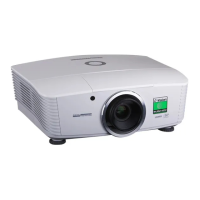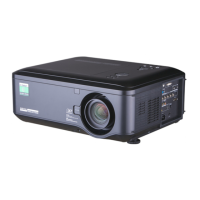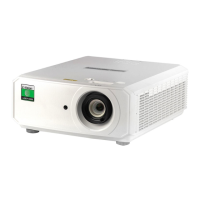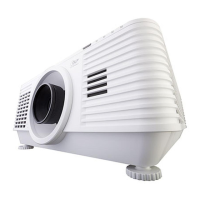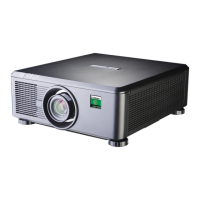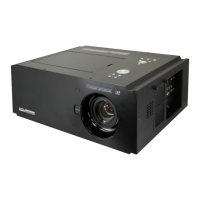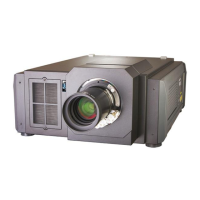Do you have a question about the Digital Projection E-Vision and is the answer not in the manual?
| Brand | Digital Projection |
|---|---|
| Model | E-Vision |
| Category | Projector |
| Language | English |
Indicates a potential hazard of eye exposure to laser radiation.
Indicates a danger of electrical shock.
Indicates a danger of physical injury or equipment damage.
Highlights important information that requires reading.
Specifies the input voltage range and frequency.
Details temperature and humidity ranges for operation and storage.
Provides the projector's size and weight without the lens.
Maximum power draw during operation and standby modes.
Indicates heat output in BTU/Hour for different voltage inputs.
Designation of the product as Class 3R laser and avoidance of eye exposure.
Instructions to avoid direct or reflected laser light exposure.
Label containing manufacturer details, model, and input specifications.
Labels detailing FDA performance standards and certifications.
Label indicating laser aperture and associated hazard warnings.
Placement of Manufacturer's ID and certification labels on the projector.
Indicates where to find the projector's unique serial number.
Placement of the hazard warning and aperture label on the projector.
Visual guide indicating the position of the laser aperture.
Explanation of how interlock switches power off the system when activated.
Rules on operating a defective unit, maintenance, and opening the cabinet.
Precautions against moisture, liquids, and electrical hazards like wet hands.
Guidelines for ventilation, post-operation cooling, and proper cleaning methods.
Caution regarding hazardous optical radiation and the risk of eye damage.
Warning on LAN cable types and power outlet grounding.
Covers professional installation, spacing, heat avoidance, and dry area placement.
Procedures for safe handling, mounting, stacking, and using safety chains.
Diagrams showing recommended projector orientations for operation.
Advice on network changes and procedures for software updates.
Information regarding radio frequency interference and FCC rules.
Details on the projector's acoustic noise level.
Commitment to minimizing environmental impact via WEEE guidelines.
Guidelines for setting up the screen and projector for optimal viewing.
Information on adjustable feet for leveling and ceiling mount holes.
Instructions for setting the voltage select switch to match the power supply.
Guidance on using the provided power cable and ensuring a ground connection.
Step-by-step instructions for turning the projector on.
Steps to turn the projector off and place it in standby mode.
How to connect various image sources to the projector.
Methods for selecting the desired input signal via remote or OSD.
Procedure to display and change through various test patterns.
Using the Lens menu for zoom, focus, and shift adjustments.
Directly adjusting lens zoom, focus, and shift using remote buttons.
Setting the projector mode for front/rear and tabletop/ceiling orientation.
Adjusting the keystone effect through the Geometry menu.
Fine-tuning picture settings like Gamma, Brightness, and Contrast.
Safety guidelines before handling and changing the projector lens.
Step-by-step guide for correctly inserting and securing the lens.
Safety guidelines before removing the projector lens.
Step-by-step guide for releasing and removing the projector lens.
Switches the projector on and off (STANDBY).
Cycles through the available input sources.
Resynchronises the projector with the current input signal.
Allows changing the aspect ratio of the displayed image.
Centers the projector lens.
Switches the laser output off or on.
Displays and exits the On-Screen Display (OSD) menu.
Used for navigating OSD menus and selecting options.
Exits the current OSD page or menu level.
Moves the lens vertically or horizontally.
Adjusts the focus of the projected image in and out.
Adjusts the zoom level of the projected image in and out.
Explanation of the status lights (TEMP, LIGHT, STATUS, POWER) for troubleshooting.
Turns the projector on and off.
Shows or hides the projected image.
Enables/disables screen timeout messages and OSD display.
Accesses or exits the projector's On-Screen Display (OSD).
Navigates menus and confirms selections.
Closes the current OSD page or returns to the previous menu level.
Freezes the currently displayed image frame.
Restores all settings to their factory default values.
Accesses information about the projector's status and settings.
Resynchronises the projector with the current input signal.
Adjusts the lens focus and zoom.
Loads and saves user-defined preset configurations.
Activates alternative functions for buttons with green labels.
Selects DisplayPort 2 input using the ALT button.
Selects HDMI 2 and HDMI 4 inputs.
Selects HDMI 1 and HDMI 3 inputs.
Displays test patterns or swaps input signals.
Selects the DisplayPort 1 input.
Selects the HDBaseT input.
Selects the 3G-SDI input.
Input selection and toggles 3D format.
Input selection and controls 3D eye dominance.
Selects the Component 2 input.
Assigns or unassigns an IR remote address for the projector.
